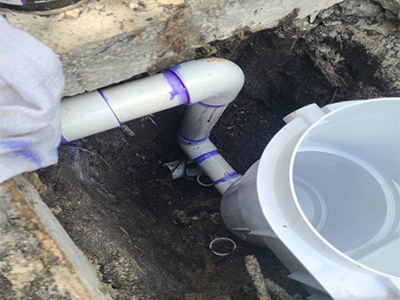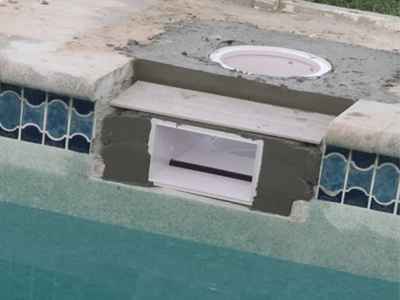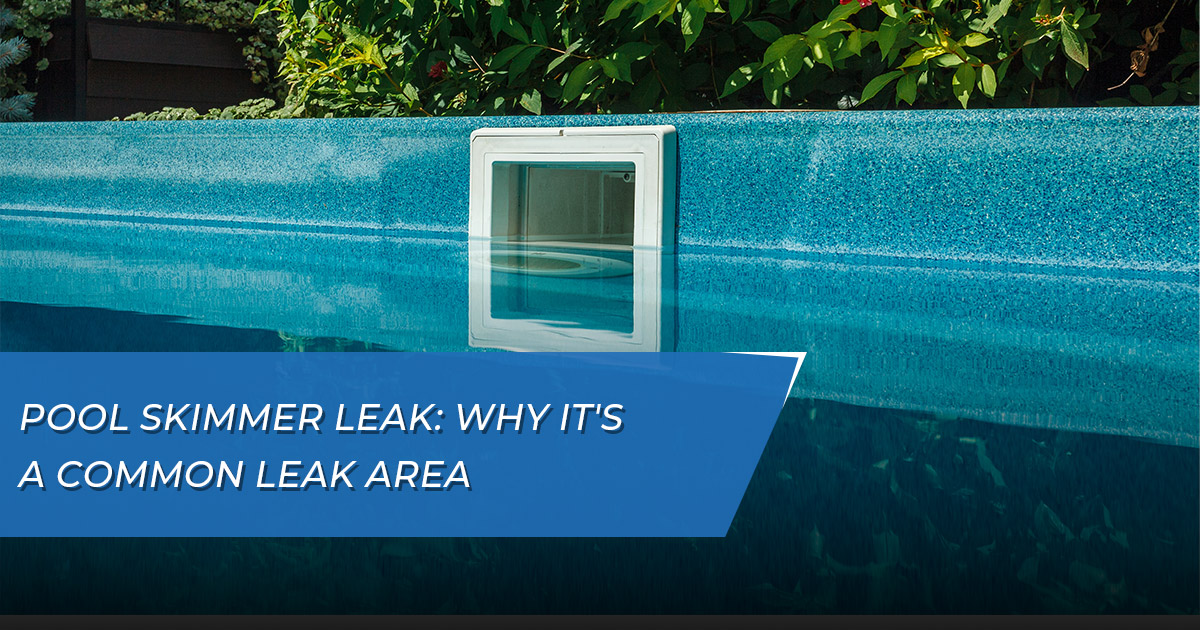Pool Skimmer Leak: Why It’s a Common Leak Area
If you suspect that you have developed a pool leak, one of the first areas you should check is the skimmer. While a pool skimmer plays an essential role in the cleanliness of your pool, it is prone to developing issues over time.
But what is a pool skimmer, what does it do, why is it prone to leaks and what do you do if you find one? The answers to all of these questions and more require you to keep a few important things in mind.
Related Article: Pool Leak Bucket Test: How and When to Do It
What is a Pool Skimmer, and What Does It Do?
 Every swimming pool has critical equipment that makes up the cleaning system, and a pool skimmer is a big part of that. It’s used to keep the surface of your pool’s water clean from not only leaves and other types of debris, but also from potential issues like insect buildup, pollen, and more.
Every swimming pool has critical equipment that makes up the cleaning system, and a pool skimmer is a big part of that. It’s used to keep the surface of your pool’s water clean from not only leaves and other types of debris, but also from potential issues like insect buildup, pollen, and more.
The skimmer is the part of your pool’s cleaning system where water leaves the pool, passes through the skimmer, and then makes its way through to the pump and filter. Many consider it to be the first stop along the way towards the clean, clear water you desire.
Related Article: Pool Leaks: Signs Types and Risks of Ignoring the Issues
How Does a Pool Skimmer Work?
A pool skimmer works in conjunction with your pool’s pump. Whenever you hear that the pool pump kicks on, the skimmer pulls in water and any debris that may be on the surface. It all then passes through what is called a weir. After leaves, bugs, and other debris pass through this point, it all gets collected in a skimmer basket that must be periodically emptied.
This process continues until the pool pump eventually turns off. At that point, the weir falls back into its original place, and it continues to help stop debris from re-entering the pool. Once this happens, you can empty the skimmer basket to make sure that your clean, clear water stays that way for as long as possible.
Should a Skimmer Run All the Time?
No, a pool skimmer should not run all the time. While it does have an invaluable role to play in pool sanitation, even when it is off, it only ever “turns on” when the pool pump does the same.
How Often Should I Empty a Skimmer?
Your pool skimmer should be emptied as necessary — when you can clearly see that a significant volume of debris has built up in the skimmer basket. This will help guarantee the continued, smooth operation of your pool’s cleaning system. It will also make sure that the debris that has been collected up to this point does not find its way back into the pool’s water.
How Do You Maintain a Pool Skimmer?
Pool skimmer maintenance should be completed on a regular basis, in large part to help preserve the longevity of both the pool pump and the filter.
Whenever your pool skimmer is cleaned, you should always visually inspect the weir to make sure that it is still functioning as intended. You should also verify the condition of the skimmer basket, as well as the lid. If you see any signs of damage or other wear and tear, your pool skimmer should be properly maintained by a professional.
What Causes a Pool Skimmer to Leak?
 Pool skimmers can potentially leak for a wide range of different reasons. Oftentimes, an in-ground pool can develop a crack at the point where your pool skimmer meets the concrete wall of the pool itself. Unfortunately, there are some situations where this could happen more frequently than others — it all comes down to how well the skimmer was originally installed in the first place.
Pool skimmers can potentially leak for a wide range of different reasons. Oftentimes, an in-ground pool can develop a crack at the point where your pool skimmer meets the concrete wall of the pool itself. Unfortunately, there are some situations where this could happen more frequently than others — it all comes down to how well the skimmer was originally installed in the first place.
Sometimes, a pool skimmer is installed into a steel frame that is part of the pool’s wall. The skimmer is then encased in concrete by the professional doing the work. This method is preferred, as it generally causes the fewest number of leaks over time.
However, in some situations, a professional may leave notches in the wall of the pool where the skimmer is to be installed. Once the wall of the pool is finished, the skimmer is then attached to it by drilling holes directly into the concrete. Rebar is then used to create a form around the skimmer, and cement is used to keep everything in place.
The issue with this second method is that the soil shifts around your pool all the time. That, coupled with the natural freezing and thawing of the environment, can cause the pool’s wall and the concrete that is encasing the skimmer to separate. Even small amounts of movement can be enough for cracks to appear, which will invariably lead to a pool leak at these points.
How Do You Detect a Skimmer Leak?
First, you should lay down and look over the pool, essentially looking into the skimmer from an upside-down position. Look to the area where the pool’s tile ends, where you’ll likely see a bit of plaster before the actual skimmer begins.
This is the area that you want to examine for cracks and other instances of debris that may have appeared. Note that, depending on the situation, any problem areas that you see could be underwater, at the water line, or even above water — all of this is why your tests must be conducted as thoroughly as possible.
If you detect that you have a skimmer leak, and you want to know for sure, you can do so using the pool dye test. This type of test uses a concentrated dye that is heavier than water. The dye is applied to the water at the point where you suspect a leak may be present — in this case, near the pool skimmer. Once the pump is turned off, and you’re certain that you’re working with perfectly still water, place the dye into the pool. If a leak is there, the dye should essentially be “sucked” into the crack at the problem area. Don’t worry — all dyes will eventually dissipate in the water if a leak is present, so you don’t have to worry about any additional cleanup to take place after.
It should be noted that the pool dye leak test works on all types of pool surfaces, including cement, vinyl, and fiberglass. This will help you determine whether a leak is truly present in or around the skimmer, at which point you can call in the help of a professional to do something about it.
Related Article: Pool Leak Detection Kits: Do They Work?
Is It Easy to Fix a Pool Skimmer Leak?
 Fixing a pool skimmer leak is a relatively straightforward process, but it does require you to keep a few key things in mind.
Fixing a pool skimmer leak is a relatively straightforward process, but it does require you to keep a few key things in mind.
First, shut off the pool’s pump and verify using methods like the dye test that you know exactly where the leak is. You must also be working at a pool level that is at least one inch above the skimmer box. If you aren’t, you need to add water to your pool.
At that point, you can remove the cover from the skimmer box. You may need to use a screwdriver to do this. Once the cover is off, carefully apply a product like pool putty to the affected area. If you complete the pool dye test, you will do this at the exact area where the dye was sucked into the pool.
Smooth out the sealant material as best you can and wait about 30 minutes for it to solidify. Once it does, it will change color. This means that you can put everything back together and turn your pool pump back on. Be sure to replace the pool skimmer box cover that you removed at the beginning of this process.
Related Article: How to Find and Fix a Pool Leak
Your Pool Leak Detection Experts
While the repair can sound simple, we suggest having professionals complete this task. If you suspect you have a leak contact the experts at GPS Pools. We offer pool leak detection services from our 3 locations in New Tampa, Land O’Lakes, and Lutz. We have 20+ years of experience doing this and other types of maintenance on behalf of customers all throughout Odessa, Pebble Creek, Tampa Palms, Wesley Chapel, Seven Springs, Keystone, Lake Fern, and more. We also proudly stock all the products you would need — from pool dye test kits to sealants and everything in between — to help this process go as smoothly as possible.

